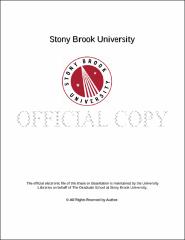| dc.identifier.uri | http://hdl.handle.net/11401/76914 | |
| dc.description.sponsorship | This work is sponsored by the Stony Brook University Graduate School in compliance with the requirements for completion of degree. | en_US |
| dc.format | Monograph | |
| dc.format.medium | Electronic Resource | en_US |
| dc.language.iso | en_US | |
| dc.publisher | The Graduate School, Stony Brook University: Stony Brook, NY. | |
| dc.type | Dissertation | |
| dcterms.abstract | Actin is the most abundant and highly conserved intracellular protein in all eukaryotic cells. Cell necrosis can release actin into the extracellular environment where conditions favor spontaneous generation of F-actin filaments. A robust extracellular actin scavenger system consisting of gelsolin and the vitamin D binding protein (DBP) has evolved to sever F-actin filaments (gelsolin) then bind G-actin monomers (DBP) for subsequent clearance. This study investigated the role of DBP in this process using the DBP null mouse that has a systemic deficiency of DBP. Intravenous injection of G-actin into wild-type (DBP+/+) and DBP null (DBP-/-) mice showed that, contrary to expectations, DBP+/+ mice developed much more severe acute lung injury. Tissue injury was restricted to the , and pathological changes were clearly evident at 1.5 and 4 hours post-injection but were largely resolved by 24 hours. In the DBP+/+ mice there was noticeably more vascular leakage, immune cell infiltration, thickening of the alveolar wall, and formation of hyaline membranes. Flow cytometry analysis of whole lung homogenates showed increased neutrophil infiltration into DBP+/+ mouse lungs. Increased amounts of protein and leukocytes were also noted in the airspaces of DBP+/+ mice 4 hours after actin injection, indicating permeability changes in the lung microvasculature. The effect of DBP-actin complexes on cultured human lung microvascular endothelial cells (HLMVEC) and human umbilical vein endothelial cells (HUVEC) was investigated next. Cells treated in vitro with purified DBP-actin complexes showed a significant reduction in cell viability at 4 hours, and this effect was reversible if cells were then cultured in fresh medium for another 24 hours. However, cells cultured in the presence of DBP-actin for 24 hours showed a significant increase in cell death (95% for HLMVEC, 45% for HUVEC). The mechanism of endothelial cell death was shown to be via the caspase 3 mediated apoptosis pathway since cells treated with DBP-actin complexes had a dramatic increase in the amount of cleaved Poly ADP ribose polymerase (PARP), a specific substrate and marker of this pathway. These results demonstrate that elevated levels and/or prolonged exposure to DBP-actin complexes may induce endothelial cell injury and death, particularly in the lung microvasculature. | |
| dcterms.available | 2017-09-20T16:51:26Z | |
| dcterms.contributor | Kew, Richard R | en_US |
| dcterms.contributor | Fleit, Howard | en_US |
| dcterms.contributor | Furie, Martha | en_US |
| dcterms.contributor | Miller, Edmund. | en_US |
| dcterms.creator | Ge, Lingyin | |
| dcterms.dateAccepted | 2017-09-20T16:51:26Z | |
| dcterms.dateSubmitted | 2017-09-20T16:51:26Z | |
| dcterms.description | Department of Biochemistry and Cell Biology. | en_US |
| dcterms.extent | 116 pg. | en_US |
| dcterms.format | Application/PDF | en_US |
| dcterms.format | Monograph | |
| dcterms.identifier | http://hdl.handle.net/11401/76914 | |
| dcterms.issued | 2013-12-01 | |
| dcterms.language | en_US | |
| dcterms.provenance | Made available in DSpace on 2017-09-20T16:51:26Z (GMT). No. of bitstreams: 1
Ge_grad.sunysb_0771E_11515.pdf: 6425770 bytes, checksum: b087c3829b50890f2f71a8c380ae7702 (MD5)
Previous issue date: 1 | en |
| dcterms.publisher | The Graduate School, Stony Brook University: Stony Brook, NY. | |
| dcterms.subject | acute inflammation, DBP-actin complexes, EASS, endthelial cells, extra cellular actin scavenging system, lung injury | |
| dcterms.subject | Immunology | |
| dcterms.title | Circulating Complexes of the Vitamin D Binding Protein with G-Actin Induce Lung Injury by Targeting Endothelial Cells | |
| dcterms.type | Dissertation | |

